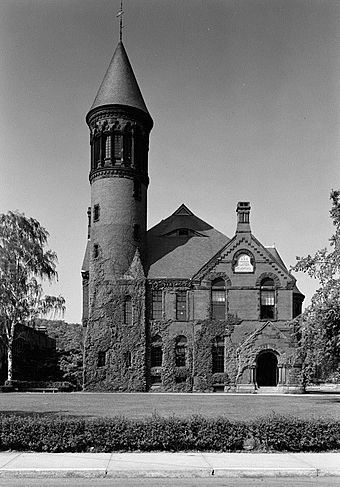Chelsea Parade Historic District facts for kids
Quick facts for kids |
|
|
Chelsea Parade Historic District
|
|

John Fox Slater Memorial Museum in 1958
|
|
| Location | Roughly bounded by Crescent, Broad, Grove, McKinley, Perkins, Slater, Buckingham, Maple Grove, Washington, and Lincoln, Norwich, Connecticut |
|---|---|
| Area | 205 acres (83 ha) |
| Built | 1850 |
| Architect | Wilson Potter |
| Architectural style | Mid 19th Century Revival, late 19th and 20th Century Revivals, late Victorian |
| NRHP reference No. | 88003215 |
| Added to NRHP | May 12, 1989 |
The Chelsea Parade Historic District is a special neighborhood in Norwich, Connecticut. It's mostly a place where people live, located just north of the city's downtown area. At its heart is the Chelsea Parade, a cool triangular park.
This area has been a popular spot for families for a long time. You can see many different styles of buildings here, some dating back to the 1700s! The district covers about 205 acres (that's like 155 football fields!). It includes 565 important buildings, two other interesting sites, and six special objects. This whole area was added to the National Register of Historic Places in 1989 because of its history.
Contents
Exploring the Chelsea Parade Historic District
The Chelsea Parade Historic District is shaped a bit like a teardrop. Its main streets are Washington Street and Broadway, which run along the Chelsea Parade park. The district also includes many homes on the smaller streets nearby.
A Look Back at Norwich's History
Norwich first started as a settlement called Norwichtown. But soon, a busy port called Chelsea Landing grew up further south. This port was where the Yantic and Shetucket Rivers meet to form the Thames River.
The Chelsea Parade area was once just open land where animals grazed. In 1726, it was divided into smaller plots. By 1740, roads were built through the area. These roads connected Norwichtown with the port.
How the Chelsea Parade Area Grew
By the late 1700s, Norwich was the biggest city in Connecticut! The Chelsea Parade area became a very popular place to live. Wealthy families built their large homes here.
In 1797, the Chelsea Parade itself was officially set aside as a public common. Over time, it became more like the beautiful park you see today. Homes and important public buildings were built around it.
The area stayed a fashionable address through the 1800s. During this time, Norwich's main businesses changed. Instead of just shipping goods, the city started making things like textiles. These factories used the power of the nearby rivers.
Important Buildings and People
One of the most impressive homes near the Parade belonged to John Fox Slater. He was the grandson of Samuel Slater, who was a pioneer in the textile industry. Today, only the carriage house from John Fox Slater's grand estate remains.
The Slater family also helped start the Norwich Free Academy, a well-known school located in the district. They also helped create the Slater Memorial Museum, which is a museum with art and artifacts.
The district also features other important buildings. These include the Nathaniel Backus House, the Broad Street School, and the Converse House and Barn. You can also find the Park Congregational Church and the beautiful St. Patrick Cathedral here.



